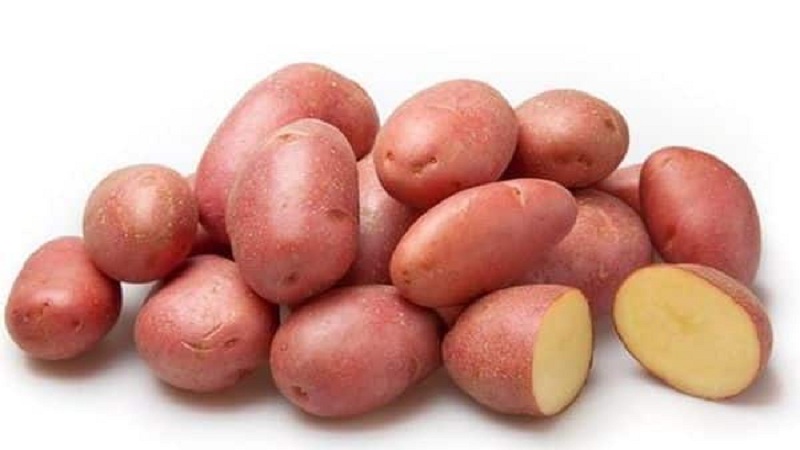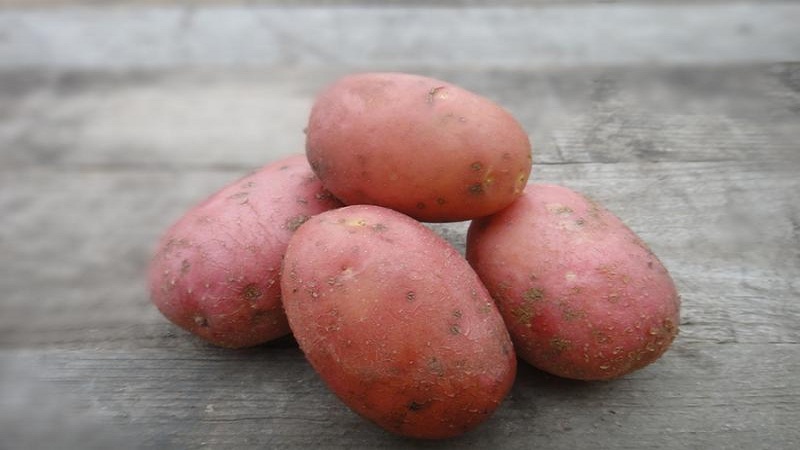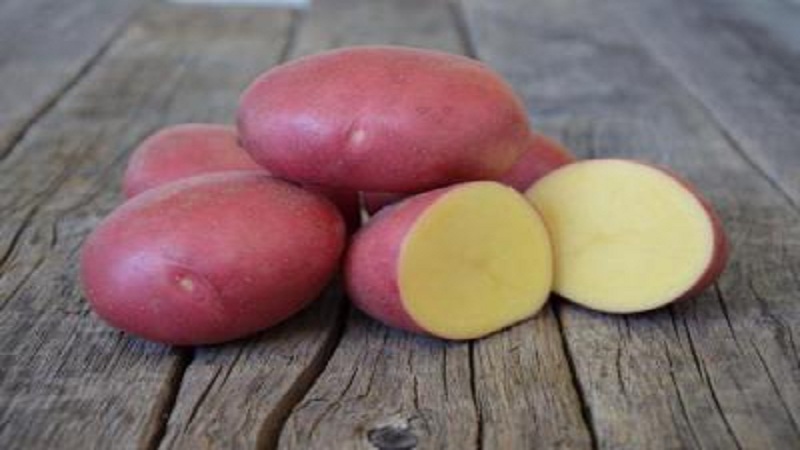An unpretentious but productive variety of red potatoes Labella
Potato variety Labella attracts the attention of gardeners and consumers with smooth tubers, pink color of the peel, unpretentious care, strong immunity to viruses and fungi. High productivity allows you to grow crops for sale and for own use.
We have prepared for you information on the standard technology of planting and growing under hay. You will learn about the advantages and disadvantages of the variety, ways to combat insect pests, rules for storing crops.
The content of the article
Origin and distinctive features of the variety
The breeders of the Dutch company DEN HARTIGH BV worked on the creation of the Labella variety. In 2011, the culture was included in the State Register of Russia.
Patent holders:
- German Seed Alliance;
- Solana RUS LLC;
- AO APK "Belorechensky";
- SEC "Agrofirm" Elite Potato ";
- Samara-Solana CJSC.
The photo shows Labella potatoes.

Description and characteristics of the culture are collected in the table.
| Indicators | Characteristic |
|---|---|
| Ripening period | Early - 70-80 days |
| Bush | Compact, upright |
| The number of tubers in the bush | 13–16 |
| Weight | 78-102 g |
| The form | Oval, slightly elongated |
| Coloration | The skin is red with eyes of medium depth, the flesh is yellow |
| Leaves | Large, intermediate type, green color |
| Corolla color | Purple with a pink tint |
| Starch content | 12–15% |
| Taste | A great |
| Cooking class / group | B (medium crumbly) |
| Yield | 176–342 c / ha |
| Marketability | 91–92% |
| Keeping quality | 98% |
| Appointment | Dining room |
| Sustainability | To cancer, golden nematode, leaf-roll virus, late blight, common scab |
| Transportability | High |
Agricultural technology varieties
Potatoes are planted in mid-April or early May, taking into account the weather conditions in each region. The variety is distinguished by increased drought resistance, but it is afraid of frost. Even with a slight decrease in air temperature at night (down to –2… –3 ° C), bushes can die.
Agrotechnical requirements are standard. It is important to water the beds on time, loosen the earthen crust, remove weeds without waiting for rooting, spud, feed them with organic and mineral compounds, inspect the bushes to quickly identify diseases and insects.
Timing, scheme and landing rules
The Labella variety is planted following standard technology:
- Previously selected tubers are taken out of storage and exposed to sunlight 3 weeks before planting. The material is sorted out and processed in disinfectant solutions with manganese or copper sulfate.
- Various healthy seeds are used for planting. Large tubers are cut into pieces, the cut is sprinkled with wood ash, and right before embedding in the ground, they are soaked for half an hour in growth stimulators "Epine", "Zircon", "Poteine", "Bioglobine" (optional).
- Potatoes grow best on loose and nutritious soil (loamy, sandy loam). Heavy soil is loosened with river sand, peat or sawdust. The soil, poor in organic matter and minerals, is dug up and fertilized with manure in the fall. Additional loosening is carried out in the spring. Too acidic soil is deoxidized by adding slaked lime, dolomite flour or ash. The optimum soil pH for potatoes is 5.2–5.7. Litmus paper is used to determine pH.
- Pits 6–8 cm deep are dug on the plot. Tubers are laid out at a distance of 30–40 cm. The beds are arranged at intervals of 60–70 cm.
Care
Planting care rules:
- Labella potatoes tolerate a lack of water, so they are watered only during a prolonged drought. 13-15 liters of water are poured under each bush.
- Loosening and weeding is carried out without fail in order to saturate the rhizome with oxygen, remove weeds.
- Hilling stimulates the formation of additional roots (stolons), increases the number of tubers and their quality, protects the plant from spring frosts. The primary hilling is carried out as soon as the bush stretches 20 cm, covering a ridge with a height of 8-10 cm. The procedure is repeated after flowering.
- At the first symptoms of fungal diseases, protective spraying with Bordeaux liquid, copper oxychloride in combination with superphosphate is carried out.
- The crops are harvested on time, as the delay reduces the yield and product quality.
Potato plantings are fertilized according to the scheme:
- the first portion is applied at planting (10 g of urea or "Solution" per 10 liters of water);
- the second - during the budding period (10 g of potassium sulfate, 30 g of wood ash per 10 liters of water);
- the third - at the flowering stage (500 ml of mullein, 15 g of urea per 10 liters of water).
Reference. Top dressing is combined with watering or produced after rain.
The nuances of growing and possible difficulties

For the cultivation of Labella potatoes, they use the method of "natural farming" - planting under hay.
Advantages of the method:
- No loosening, weeding, hilling and fertilization required.
- Inside the hay, a constant temperature that is comfortable for the plant is maintained and a useful microflora develops.
- The products are environmentally friendly - no chemicals are used to process the plantings.
- Seedlings are reliably protected from night frosts.
- The bushes are not affected by the Colorado potato beetle and wireworm.
- The soil receives sufficient nutrition under the potato plantings.
- A clean, dry crop that is easy to harvest.
Among the cons:
- Risk of eating tubers by field mice.
- The need to harvest a large amount of hay.
- Rotting tubers and the appearance of slugs due to excess moisture.
Technological process:
- Harvesting about 20-30 m³ of hay, straw, or sowing green manure with subsequent mowing.
- Landscaping and germination of tubers before planting.
- Seed treatment with Heteroauxin, Epin-extra stimulants and Emistim protective solution to increase resistance to late blight and viruses.
- Moistening the soil with warm water.
- Surface loosening of the soil and the formation of furrows 5–7 cm deep. The distance between rows is 65-70 cm.
- Laying the planting material into depressions powdered with ash, at a distance of 40 cm.
- Uniform distribution of hay in a layer of 20 cm, straw - no more than 40 cm.
- Planting a black root on the site to scare away mice.
The plot does not need to be watered throughout the growing season. In a drought, it is recommended to equip a drip irrigation system to feed the plantings with moisture no more than 1 time per month.
When the sprouts are 5–7 cm long, another layer of mulch 15–20 cm high is placed on top. Straw acts as a natural fertilizing, so no other fertilizers need to be used. Mulch blocks the growth of weeds, saving gardeners from weeding.
It is interesting:
How to get rid of warts with potatoes.
How to check potatoes for nitrates at home and what is it for.
Diseases and pests
The Labella variety is resistant to viral and fungal diseases, but experts recommend not neglecting prevention methods.
Measures to prevent diseases and pest attacks:
- compliance with crop rotation;
- rarefaction of landings;
- lack of tomatoes and eggplants in the neighborhood;
- pre-planting treatment of tubers in potassium permanganate, copper sulfate, Fitosporin, Emistim;
- timely harvesting of weeds, tops and crops;
- planting green manure (rapeseed, flax, corn, rye, wheat, oats, legumes, mustard);
- destruction of insect pests.
Potato bushes are most often affected by the wireworm (larvae of the click beetle) and the Colorado potato beetle.One of the best drugs for the fight against a striped pest is recognized as "NO Colorado potato beetle!"
The biological product contains Indian azadirachta oil. The organic composition is completely safe for plants, humans and bees. The tool blocks the ability of adults to reproduce and inhibits the development of larvae.
During the season, three treatments are carried out with an aqueous solution of 1:40. The first spraying of tubers - before planting, the second - immediately after germination, the third - 14 days after the second. 10 ml of the product is enough for one hundred square meters.
Chemicals are also effective:
- "Prestige";
- "Bankol";
- "Confidor";
- "Commander".
With a small number of beetles on the bushes, manual collection is used or baits are installed. For example, old tubers are cut into pieces, soaked in chlorophos solution for 24 hours, then scattered on the site. This is done in the evening or in cloudy weather, since the tubers dry out in the sun and cease to attract the pest. The manipulation is repeated after harvesting in order to finally "finish off the enemy".
Wireworms - the larvae of the click beetle - cause a lot of trouble for gardeners, gnawing holes in the tubers. The pest prefers to hide in young seedlings of corn, barley, wheat. 14 days before planting potatoes, these crops are sown on the site, having previously treated the seeds in any insecticide. Then the plants are dug up together with the pest.
Ground eggshells laid out along the perimeter of the site, a weak solution of potassium permanganate and an infusion of nettle with dandelion (0.5 kg of freshly cut grass / 10 l of water) under the root will help scare off the wireworm.
Collection, storage and use of the crop

Labella tubers are resistant to mechanical damage. The wounds that appear during the digging process quickly heal, and the potatoes retain their presentation.
Harvest storage:
- The tubers are cleaned of soil and laid out in a dark place to dry.
- The potatoes are examined for putrefactive lesions, put in boxes, nets, bags, and several apples or beets are placed on top. Such a neighborhood prevents the germination and rotting of fruits.
- On an insulated balcony or loggia, the harvest is stored in boxes with foam or foil screen, "balcony cellars".
- The fruits are sorted from time to time, rejecting rotten and green tubers.
- Potatoes withstand any heat treatment and do not fall apart into porridge. It is suitable for cooking boiled, stewed, baked, fried foods. The pulp does not darken after cooking.
Advantages and disadvantages
Variety advantages:
- ease of care;
- drought resistance;
- early maturity;
- great taste;
- high level of transportation;
- long shelf life;
- strong immunity;
- optimal starch level;
- no need for careful sorting of the crop.
The disadvantage is the instability of the culture before frost.
Regions suitable for cultivation
The Labella variety was initially approved for cultivation in the Central, North Caucasian, Middle Volga, Ural regions. Over time, the geography of cultivation has expanded, and now potatoes can be found in almost every corner of the country with a temperate and warm climate.
Reviews
Reviews of Labella potatoes are positive. The variety is appreciated for its pronounced potato flavor and aroma, disease resistance and ease of care.
Irina, Moscow: «For a long time I was looking for a variety that tastes like potatoes from childhood. I saw these pink, even tubers with yellow pulp at a neighbor in the country and asked to share. When I tasted the potatoes, I realized: this is what you need. Variety Labella is quite fruitful and unpretentious to care for, lying, does not get sick. I advise everyone to try to grow it on their site. "
Vladislav, Stavropol: “I have been growing Labella for several years in a row. The variety is liked for its strong immunity to many diseases. At least, the bushes on my site have never been sick. The tubers have a dark pink skin and yellow flesh.They boil poorly in water, are more suitable for frying and baking.
Galina, Magnitogorsk: “For me this is the best potato court, except for it I don't plant anything else. The tubers are even, they do not get sick, you don't even need to sort, the taste is excellent. When boiling, the potatoes do not boil into a paste, but retain their shape. "
Read also:
What is the danger of potatoes and can they be poisoned.
Conclusion
The Dutch potato Labella has won a nationwide vocation due to its high yield, drought resistance, pleasant taste and unpretentious care. Resistance to most diseases of the nightshade greatly simplifies the cultivation technique, which boils down to preventive measures (crop rotation, disinfection of tubers before planting, extermination of insects, harvesting weeds).
The tubers contain a small amount of starch, which allows the product to be widely used in cooking. The crop does not require sorting, it is stored for a long time in a cool place, and the damage that occurs during digging heals quickly.